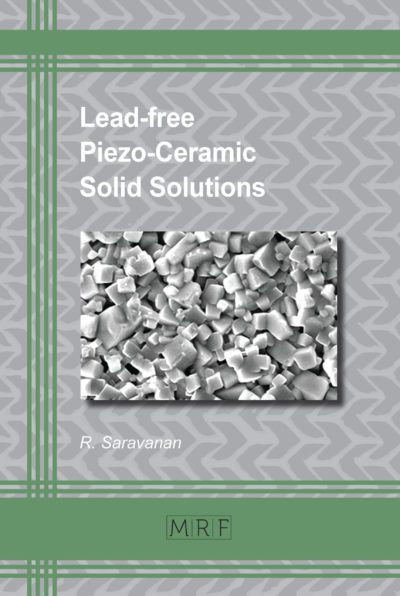Synthesis and Structural Characterizations of Na1-xKxNb0.95Sb0.05O3
S. Sasikumar, R. Saravanan
Solid solutions of lead free ceramics of Na1-xKxNb0.95Sb0.05O3 (x=0.01, 0.03 and 0.05) were prepared by the conventional solid state reaction method. The formation of perovskite structure of the prepared ceramics was confirmed by means of room temperature powder X-ray diffraction. X-ray powder diffraction analyses revealed the persistence of an orthorhombic phase. The crystal structures were refined using profile refinement. Aggregated average particle sizes were evaluated using scanning electron microscopy. Elemental compositional analysis was carried out using energy dispersive spectrum.
Keywords
Crystal Structure, X-Ray Diffraction, Rietveld Analysis, Scanning Electron Microscopy
Published online 6/1/2016, 11 pages
DOI: 10.21741/9781945291036-15
Part of Novel Ceramic Materials
References
[1] T.-Y. Chen, S.-Y. Chu, C.-K. Cheng, Doping effects on the piezoelectric properties of low-temperature sintered PbTiO3-based ceramics for SAW applications, Integrated Ferroelectrics 58 (2003) 1315–1324.
https://dx.doi.org/10.1080/714040790
[2] S.-Y. Chu, T.-Y. Chen, W. Water, The investigation of preferred orientation growth of ZnO films on the PbTiO3-based ceramics and its application for SAW devices, Journal of Crystal Growth 257 (2003) 280–285.
https://dx.doi.org/10.1016/S0022-0248(03)01452-0
[3] S.-Y. Chu, T.-Y. Chen, I.T. Tsai, Effects of poling field on the piezoelectric and dielectric properties of Nb additive PZT-based ceramics and their applications on SAW devices, Materials Letters 58 (2004) 752–756.
https://dx.doi.org/10.1016/j.matlet.2003.07.004
[4] B. Jadidian, N. Hagh, A. Winder, A. Safari, 25 MHz ultrasonic transducers with lead-free piezoceramic, 1-3 PZT fiber-epoxy composite, and PVDF polymer active elements, IEEE Transactions on Ultrasonics Ferroelectrics and Frequency Control 56 (2009) 368–378.
https://dx.doi.org/10.1109/TUFFC.2009.1046
[5] K.-T. Chang, H.-C. Chiang, C.-W. Lee, Design and implementation of a piezoelectric clutch mechanism using piezoelectric buzzers, Sensors and Actuators A: Physical 141 (2008) 515–522.
https://dx.doi.org/10.1016/j.sna.2007.10.018
[6] Z. Yang, X. Chao, R. Zhang, Y. Chang, Y. Chen, Fabrication and electrical characteristics of piezoelectric PMN-PZN-PZT ceramic transformers, Materials Science and Engineering B: Solid-State Materials for Advanced Technology 138 (2007) 277–283.
https://dx.doi.org/10.1016/j.mseb.2007.01.031
[7] C.-W. Ahn, H.-C. Song, S. Nahm, S. Priya, S.-H. Park, K. Uchino, H.-G. Lee, H.-J. Lee, Effect of ZnO and CuO on the sintering temperature and piezoelectric properties of a hard piezoelectric ceramic, Journal of the American Ceramic Society 89 (2006) 921–925.
https://dx.doi.org/10.1111/j.1551-2916.2005.00823.x
[8] T. Takenaka, T. Gotoh, S. Mutoh, T. Sasaki, New series of bismuth layer structured ferroelectrics, Japanese Journal of Applied Physics Part 1: Regular Papers Short Notes and Review Papers 34 (1995) 5384–5388.
https://dx.doi.org/10.1143/JJAP.34.5384
[9] M. Hirose, T. Suzuki, H. Oka, K. Itakura, Y. Miyauchi, T. Tsukada, Piezoelectric properties of SrBi4Ti4O15-based ceramics, Japanese Journal of Applied Physics Part 1: Regular Papers Short Notes and Review Papers 38 (1999) 5561–5563.
https://dx.doi.org/10.1143/JJAP.38.5561
[10] Y. Saito, H. Takao, T. Tani, T. Nonoyama, K. Takatori, T. Homma, T. Nagaya, M. Nakamura, Lead-free piezoceramics, Nature 432 (2004) 84– 87.
https://dx.doi.org/10.1038/nature03028
[11] J. Acker, H. Kungl, M.J. Hoffmann, Influence of alkaline and niobium excess on sintering and microstructure of sodium–potassium niobate (K0.5Na0.5)NbO3, Journal of the American Ceramic Society 93 (2010) 1270–1281.
https://dx.doi.org/10.1111/j.1551-2916.2010.03578.x
[12] O.P. Thakur, C. Prakash, A.R. James, Enhanced dielectric properties in modified barium titanate ceramics through improved processing, Journal of Alloys and Compounds 470 (2009) 548–551.
https://dx.doi.org/10.1016/j.jallcom.2008.03.018
[13] C.-W. Ahn, D. Maurya, C.-S. Park, S. Nahm, S. Priya, A generalized rule for large piezoelectric response in perovskite oxide ceramics and its application for design of lead-free compositions, Journal of Applied Physics 105 (2009).
https://dx.doi.org/10.1063/1.3142442
[14] S.-Y. Chu, W. Water, Y.-D. Juang, J.-T. Liaw, Properties of (Na, K)NbO3 and (Li, Na, K)NbO3 ceramic mixed systems, Ferroelectrics 287 (2003) 23–33.
https://dx.doi.org/10.1080/00150190390200767
[15] Q. Zhang, B. Zhang, H. Li, P. Shang, Effects of Na/K ratio on the phase structure and electrical properties of NaxK1-xNbO3 lead-free piezoelectric ceramics, Rare Metals 29 (2010) 220–225.
https://dx.doi.org/10.1007/s12598-010-0038-y
[16] W. Jiagang, X. Dingquan, W. Yuanyu, W. Lang, J. Yihang, Z. Jianguo, K/ Na ratio dependence of the electrical properties of [(KxNa1-x)0.95-)0.95Li0.05](Nb0.95Ta0.05)O3 lead-free ceramics, Journal of the American Ceramic Society 91 (2008) 2385–2387.
https://dx.doi.org/10.1111/j.1551-2916.2008.02415.x
[17] M. Matsubara, T. Yamaguchi, W. Sakamoto, K. Kikuta, T. Yogo, S.-I. Hirano, Processing and piezoelectric properties of lead-free (K,Na) (Nb,Ta) O3 ceramics, Journal of the American Ceramic Society 88 (2005) 1190–1196
https://dx.doi.org/10.1111/j.1551-2916.2005.00229.x
[18] M.-R. Yang, C.-S. Hong, C.-C. Tsai, S.-Y. Chu, Effect of sintering temperature on the piezoelectric and ferroelectric characteristics of CuO doped 0.95(Na0.5K0.5)NbO3–0.05LiTaO3 ceramics, Journal of Alloys and Compounds 488 (2009) 169–173.
https://dx.doi.org/10.1016/j.jallcom.2009.07.174
[19] R. D. Shannon, Revised effective ionic radii and systematic studies of interatomic distances in halides and chalcogenides, Acta Cryst. A32 (1976) 751-767.
https://dx.doi.org/10.1107/S0567739476001551
[20] V. Petricek, M. Dusek and L. Palatinus, (2006) Jana, The crystallographic computing system (Institute of Physics), Praha, Czech Republic.
[21] H.M. Rietveld, A Profile Refinement Method for Nuclear and Magnetic, J. Appl. Crystallogr. 2 (1969) 65.
https://dx.doi.org/10.1107/S0021889869006558














